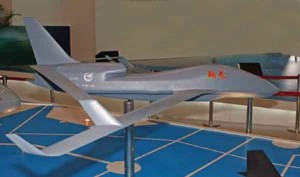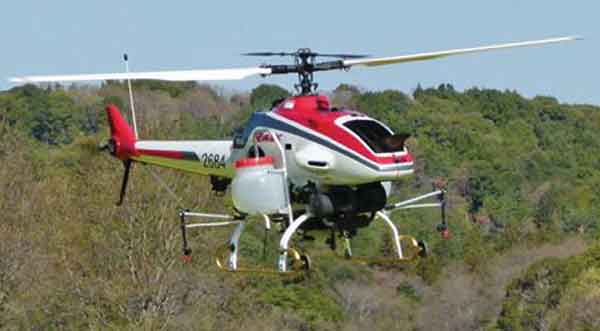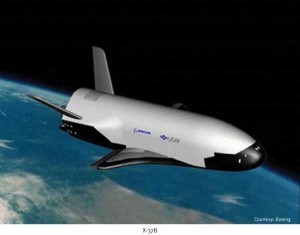Current Status And Future
PLA’s ambitious UAV development covers the gamut from micro to tactical to strategic, and could soon include stratospheric space air ships and hypersonic platforms. At the third biennial vanguard UAV exhibition in June 2010, 70 UAV related companies displayed their wares. At the November 2010 Zhuhai air show, 25 indigenous UAVs were shown. This is a record number for a country that showcased its first concept UAV only four years ago. Continued development of so many types of UAVs simultaneously supports the PLA’s strategy of Information Warfare/Informatisation. There is considerable interest in near space or stratospheric UAVs. A lot of research is directed towards this concept. Also finding prominence in research is developments of hypersonic UAVs/UCAVs for near space; Earth orbit missions. In 2007, Chinese sources revealed the Chengdu Shenlong, a small space plane about the same size as the Boeing X – 37B space plane.8
PLA’s ambitious UAV development covers the gamut from micro to tactical to strategic…
What is significant about Chinese effort in UAVs is the all across development from micro to stratospheric models; the number of aviation companies and Universities involved and the pursuit of technology that is considered future of military aviation. Some of the models are designed to fire air to ground missiles. The latest, most ambitious programme is the WJ 600, details of which are placed at the end. However, no precise details are available as to which of the UAVs are fully operational. The lists towards the end show all the models developed so far and the list of UAVs in use with PLA and PLAAF. The development of HALE and MALE is to enable long-range ISR and strikes coupled to Chinese Beidou GPS. This long range capability will be free of US GPS. While the Chinese UAVs are still behind US and Israeli UAVs in performance, the noteworthy fact is the rapid pace at which China is trying to reduce this gap.
Undoubtedly, Israel has helped in this race, starting with the sale of the Harpy anti-radar killer UAV in 1994 to the fury of Pentagon which has since blocked the Israelis from providing upgrades.9 China has also converted old fighters namely the J-5, J-6 and J-7 into UAVs for use as targets. Possibly up to 300 J-6 could be launched on one way missions against Taiwan.10 Modern integrated warfare in which the American and Israeli forces excel cannot be learnt in isolation. It is the result of evolutionary learning tested and refined time and again under war conditions. This means China’s operational concepts are likely to remain far from perfect for a long time to come. We must then see the use of UAVs by Chinese in this light.
China’s massive UAV developmental work has unhealthy implications for India. Soon Chinese capability will be of the latest standard and massive in size. If and when integrated in a manner similar to the Americans, the Chinese will have great knowledge of battle space. The Himalayan terrain is such that it is not easy to conceal and camouflage effectively. The stealthy nature of newer UAVs will make it difficult for India to intercept them. We need fighters with AESA radar to be able to intercept Chinese UAVs. We will need to find the UAV bases and attack them on the ground. We need a massive investment in our own ISR assets and more important in DATA FUSION architecture. This is one area where we have a slight lead but need to work vigorously in making it really centralised and networked.
Chinese UAVs in Service11
Wikipedia has listed a total of 35 Chinese UAVs. The UAVs in service are listed below:
PLA
- ASN – 15 (hand-launched)
- ASN – 104
- ASN – 105
- ASN – 206
- W – 50
- WZ – 5
- D – 4 NPU (Xian NPU)
- WZ – 6 BZK – 006 & BZK – 005
PLA-AF
- CH – 1 Chang Hong
- Chang Kong – 1
- BQM – 34 Fire bee
- Harpy
(In the table given below, data on all the UAVs in China has been complied by analysing reports in Aviation Week & Space Technology, Wall Street Journal, Jane’s World’s Air Forces and Wikipedia)
Chinese UAVs
| Name | Manufacturer | Role | Remarks |
| Chang – Hong 1 | CAF | Multi | Sensors include TV, IR & Still cameras. The next version CH – 3 is armed with AR – 1 ground attack missile. |
| Tian Yi | CAC Changdu | HALE | Similar to Global Hawk in design but 2/3rd its size. Year 2008. |
| Chang Kong – 1 | Heavy | ||
| Long Haul Eagle | CAC Changdu | HALE | Similar to Global Hawk. |
| Soar Eagle/Dragon | GAC Guizhou | HALE | Weight 7500kg.Box wing configuration.
Payload 650kg. Range – 7000km. Span – 25m. Synthetic Aperture Radar likely. Year – 2006 |
| Pteroductyl –1 | GAC Guizhou | MALE/ UCAV | Appears similar to US Predator in size. Has 20 hours endurance. Armed with Norinco BA–7 optically guided missile. Shown in Nov 2010 Zhuhai air show. Unconfirmed reports of in service. |
| Warrior – Eagle | SAC Shenyang | UCAV | A subsonic turbofan UCAV with forward swept wing. Year – 2008. |
| Anjian/ Hidden – Sword/ Dark Star | SAC Shenyang | UCAV | Stealthy, supersonic for anti – air missions. Single engine with a raked under slung intake, delta wings and twin stabilizers. Fire bee type UAV. Continues in service. |
| ASN – 105ASN – 106 | ASN | Medium | In service with Army. |
| ASN – 206 | ASN | Medium | Truck launched; Range 150km; 6-8 h endurance. In use with Army to support long range strikes by PHL03-300 mm multiple rocket system. |
| WZ – S | Heavy | ||
| BZK – 005 | Heavy/HALE | Similar to Israeli Heron, twin boom, pusher piston engine. Payload 150kgs. | |
| ASN – 104 | ASN | Light | |
| W – 50 | Light | ||
| WZ – 6 | |||
| BZK – 006 |
Chinese UAVs: Under Development
Micro UAVs/Tactical UAVs
| Name | Manufacturer | Weight | Remarks |
| Whirl –Wind Scout | AVIC | 8 kg | Ducted fan, vertical take-off model. 20-40 min endurance. Year 2010. Navigation up to 100 way points. Similar to Honey Well’s ducted fan UAV. Ceiling 3000m, cruise 60km/h. Man Sp – 90km/h. GPS/INS guided. Perch & stare. Noise 60dBA. |
| ASN – 211 | ASN | 220gms | Large duck size. 30 cm wing span, has flapping wings. Hover and take off vertically. 200m ceiling. Speed 10m/sec. |
| W – 1 | 1.75kg | Electric powered. Hand launched. Lap top controlled. 1 hr endurance. | |
| ASN – 15 | 6.5kg | Hand launched. PLA trials on. | |
| W-50 | Nanjing Research Inst | 100Kg | 4-6 hrs endurance. Year 2000. In use with PLA. |
| U-8E | 220 Kg | 4 hrs endurance. Year 2006. | |
| Servi-Helo | 120 Kg | Vertical take-off UAV. 1.5 hrs endurance. | |
| Blue Arrow UR-JI-001 | Zhuhai X.Y.Aviation | 200 Kg | Three prototypes under testing with German prop-driven engines. |
| Sky Eyes UR-CZ-008 | Zhuhai X.Y.Aviation | 40 Kg | Two prototypes under testing. |
HALE / MALE UAVs/UCAVs
| Name | Manufacturer | Weight | Remarks |
| Soar Bird LE – 300 | 900kg | Similar to Northrop Grumman Fire Scout. Vertical take – off UAV. | |
| CH – 3 | CASC | Uses a canard similar to US home built aircraft –Vari-eze. Has ‘12-hour endurance’. Armed with FT- 5 small Sat-nav guided bomb & AR – 1 optically guided missile similar to BA- 7. Shown in 2008 Zhuhai air show. Pakistan is testing a version of CH – 3. EW capable. | |
| WZ – 2000 | Guizhou – Chengdu | HALE | Twin engine turbo-fan UAV. Delta design. Resembles Global Hawk. Year 2002 |
| Dark Sword | UCAV | Year 2006 | |
| ASN – 229A | ASN | UCAV/800kg | 5.5m long. Range 2000kms.‘20-hour endurance’. Satellite data links.
Cruises at 180km/h. Has air to ground missiles. Day & night capable. |
| WJ – 600 | CASIC | UCAV | Jet engine. Carries air to ground missiles. Target data relay. Synthetic Aperture radar. EW systems. KD – 2 air to ground msl Similar to Hellfire. Also on show were two unidentified weapon systems namely TB1 & ZD1. |
Innovative New Chinese UAV –WJ 600
The latest UAV pictures from China show a UAV with a joined wing and tail that could considerably increase range and payload. Analysts are suggesting that the new Chinese UAV design — with its 60,000-ft. cruising altitude, 460-km radar surveillance range and low radar reflectivity if it uses the right composite structure — could serve as the targeting node for China’s anti-ship ballistic missiles. This UAV, most likely Chengdu Aircraft Corporation’s (CAC) production, shows a new design featuring a novel joined-wing layout. In the same size class as the General Atomics-Aeronautical Systems Inc.
 Avenger, and powered by a single turbofan engine, the new UAV is the most advanced Chinese design seen to date and the largest joined-wing aircraft known to have been built. CAC officials say it has a wingspan of 75 feet, length of 45 feet and a cruise altitude of 55,000-60,000 feet. Its take-off weight is 7,500 kg with a 6,800 km range. The company also makes a Global Hawk-like maritime reconnaissance UAV called the Xianglong, or Soaring Dragon, which flew in December 2009. The fore-body is bulged to accommodate a high-data-rate satcom antenna. Joined wings, a sub-set of closed-wing systems, comprise a sweptback forward wing and a forward-swept aft wing.
Avenger, and powered by a single turbofan engine, the new UAV is the most advanced Chinese design seen to date and the largest joined-wing aircraft known to have been built. CAC officials say it has a wingspan of 75 feet, length of 45 feet and a cruise altitude of 55,000-60,000 feet. Its take-off weight is 7,500 kg with a 6,800 km range. The company also makes a Global Hawk-like maritime reconnaissance UAV called the Xianglong, or Soaring Dragon, which flew in December 2009. The fore-body is bulged to accommodate a high-data-rate satcom antenna. Joined wings, a sub-set of closed-wing systems, comprise a sweptback forward wing and a forward-swept aft wing.
Notes
- Global Security.Org
- Aviation Week & Space Technology, January 2, 2012, p. 58.
- Ibid. p. 58.
- The Economist, March 10, 2012, p. 17.
- The Economist January 7, 2012, p. 70.
- Rand, “Analysing Chin’s Defence Industry and Implications for Chinese Military Modernisation” Evan S. Medeiros, Feb 2004.
- AW&ST Sep 12, 2011, p. 20.
- http://www.aviation week.com/aw/jsp-includes/articles. China seeks Seeks UAV Capability, Richard D Fisher.
- The Wall Street Journal, “China’s New Drones Raises Eyebrows” Jeremy Page-http://online.wsj.com/article/SB 100014240527487033743045756….1/1/2007.
- Jane’s World Air Forces ISSUE 34-20111, p. 135.
- Military Balance 2010, pp. 376-405.






